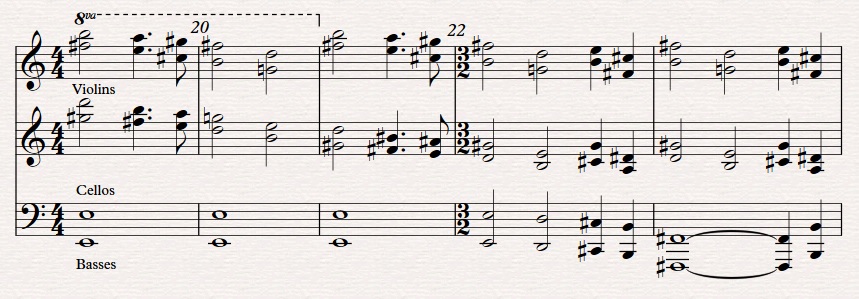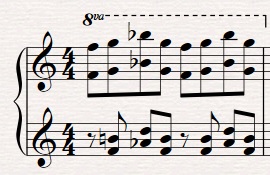Delius’ set of 4 North Country Sketches were written between 1913-14, when Delius was at the height of his writing career. By this time he had developed what has come to be known as the ‘Delius sound’ and was writing prolifically.
In this analysis I will be looking at the second of these four pieces, with particular emphasis on how Delius harmonises the same 4 bar melody in various ways. I will be using the piano reduction by Peter Warlock (which can be viewed in full here) for ease of reading.
A key signature is not used in the piece, presumably because the music never settles in a key long enough for it to be heard as the tonic. It is written in a slow 4/4 (though there are some 3/2 bars later in the piece). The piece begins very quietly (as most of Delius’ compositions from this time do), with a tonally ambiguous F diminished chord. This chord is arpeggiated by the English Horn, Oboe and Harp, while the first Violins hold a sustained G natural above it. Already an atmosphere has been created and the tempo established.

This Harp and Oboe ostinato is present for almost the whole piece, later joined by the Flutes and adapting itself to the changing harmony. This first bar then repeats verbatim while the main motif of the piece is introduced underneath it. I’ll refer to this as motif A for the remainder of the analysis. It is heard another 9 times throughout the piece in full and countless other times in fragments. It is first played by the Cellos in bar 2:

I have bracketed the last two notes as they do not form part of the motif when it reoccurs later in the piece. Harmonically these opening bars are very hard to pin down to a specific key. Motif A seems to suggest C harmonic minor, and I’ll refer to it as being in this key for the rest of this analysis. However, the Bbs which form part of the four note ostinato played by the Harp and the Oboes would seem to contradict this.

I think the answer to this is that the Bbs, being in a register over an octave above the Cello melody, are not really heard as a harmonic element. As well as this, a Bb would form part of the C natural minor scale, which is obviously closely related to the C harmonic minor tonality of the lower parts.
After this first introduction of motif A we hear it straight away again, this time in the Violas. This melody is played a perfect 5th up from before, but it is not an exact modulation.

This is basically a major key version of the first version of motif A. Despite these changes in pitch, the rhythm and contour of the motif is clearly recognisable from before. This is the first of many variations of motif A that are heard in the piece.
Underneath this we hear some very typical Delian harmony, using French augmented sixth chords (a full explanation of which can be found here) and chromatic harmony (full explanation here).

Throughout this piece Delius uses a combination of chromatic, modal and diatonic harmony, at times using distantly related chords and treating them more as sounds in themselves rather than diatonic elements, whilst in other instances using fairly conventional tonal relationships.
Again, no linking material is used and we move straight on to the next variation on motif A. As before, the instrumentation has changed and we hear the melody in the brass for the first time.

Once again, the pitches of motif A have been slightly adapted to fit the harmony. This time the melody is heard in C major, but with the last note chromatically altered to an Eb rather than the expected D. Despite this, the harmony here actually suggests a key of G major. Delius begins with one of his favourite sounds; a D dominant ninth chord. This then moves to an Am7/G (another chord which occurs often in Delius’ music) in bar 10. So far everything has remained with the key of G major (the Eb in bar 9 is a chromatic passing note). A C minor 6th chord is then heard at bar 11. This can be seen as a minor plagal chord (chord IV being minor in a minor key), meaning that it would still resolve to G as its tonic. We then stay in G major until bar 13 which is another dominant ninth chord, this time leaving the key of G major and acting as a secondary dominant chord to the E minor seventh which is heard in the following bar.
The last two bars of this section (bars 12-13) are the first appearance of linking material between the variations of motif A. They are not related to the main motif in any obvious way and act as a bridge between two versions of it. We then continue to the fourth version of motif A.

The actual melody is slightly hard to read here, so I’ve written it out in isolation.

This is actually an exact repetition of the second version of motif A, though this time in G major rather than Bb major. The harmony underneath this moves from a II-V progression in D major, down a tone to a II-V progression in C major (the V in D major also acting as a secondary dominant to the II in C major). This is a progression more associated with Jazz, especially with the extensions Delius uses here, adding 7ths, 9ths and 13ths to the basic triads.
Following these four variations on motif A, the music changes direction and becomes much more static harmonically. Very high sustained chords in the Violins come to the foreground over an E pedal note in the Cellos and Basses.

The chords in the Violins here are all 6th and 7th chords and move between the keys of A major, G major and E major. These chords all move in parallel and are heard as blocks of moving harmony over the pedal note, rather than a harmonic progression. The highest notes here form a version of motif A, the rhythm unaltered from before, and the pitches still following a descending line, though only the first two bars of the original motif A are used. From beat 4 of bar 22 onwards we hear some additional material which is not derived from motif A. In the last two bars of this section the bass also descends to create a variation under the Violins, which repeat every phrase they play.
This texture does not last long however as Delius uses an abrupt modulation into D minor, with much the same texture as before to introduce more variations of motif A.

The main variation that Delius has introduced to these to version of motif A is that they are now 3 bars long rather than 4. The first 3 bars are clearly within the key of D melodic minor, in the motif and in the harmony, and again this set of pitches has not been heard before in the piece, this time starting on the root of the minor key.
The following 3 bars are more ambiguous. The motif itself is in C major (as heard in bars 9-10), but the harmony seems to suggest a key of G minor until the Bb dominant ninth chord in bar 29. Again chromatic lines are used in the inner parts here.
In the next 6 bars the motif is shortened again, from 3 bars to 2. Delius takes just the first 2 bars of motif A and varies it harmonically, the same idea that was used in the Violins at bar 19.

This is a more conventional sequence with the melody in bars 32-33 being an exact repetition of bars 30-31 a tone apart. Although the harmony also modulates by a tone from F major to G major, the chords themselves don’t follow this pattern, though the downward direction of the melody is mirrored in the chords beneath it. Delius then uses another abrupt modulation to a B dominant ninth chord.
This chord is then reduced to just its root and 5th in the Basses and Cellos, whilst the Violins play parallel 6th and 7th chords above it in much the same way as at bar 19, though now a perfect 5th higher.

Again the same phrase is used to end this section as it was at bar 22. This 4 note idea is then used again in the next section which has departed completely from motif A.

After the F#m6 arpeggio in the Harp, we hear the same melody in the Oboes as was played by the strings at bars 39-40. This phrase has by this point almost become a secondary motif, though it features in the piece much less than motif A.
Finally, we return to the original texture, the Harp and Oboes playing the same figure they began the piece with.

Underneath this, a satisfying symmetry rounds off the piece in the form of motif A for the final time (played by solo Cello and solo Bassoon), in C minor the key in which it first occurred at bar 2. The strings underneath this change the complexion of these final few bars though, by playing a Db7 chord under the melody. The G, Bb and D in the Oboe and Harp part actually extend this chord to an implied Db13(b9#11).

The G which would normally end motif A in this key, this time resolves to an F (the 3rd of the Db7 chord) to finish the piece, albeit it in a fairly open way. Again there are some harmonic discrepancies here between the melody and the chords. The D in the Oboes would suggest a chord of Db7(b9), yet motif A begins with an Eb, suggesting Db9. Also, the C in motif A clashes with the B in the chords played underneath it. It is typical of Delius to ignore these inconsistencies in the harmony, and as with most of the clashes in Delius’ music, they are not heard as being particularly dissonant in context.
What really fascinates me about this piece is how much Delius has done with so little. Motif A consists of only 6 notes, yet he has managed to create a piece roughly 4 minutes long using only this short melody as a starting point. This is partly due to his use of orchestration, putting the motif in a different context and colour each time we hear it, but also due to his harmonic ideas. Not only does the motif modulate through various keys (and types of keys), but the harmony underneath it is never once repeated. These 52 bars are a masterclass in harmonic variation.